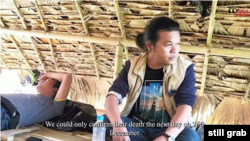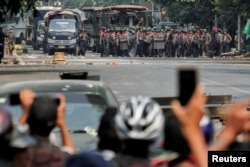Scores of journalists arrested, at least two killed and several news outlets banned. Myanmar’s junta cracked down on the media at an alarming rate.
And with militias across the country resisting military rule, reporting in Myanmar has become even more dangerous.
The risks independent journalists must take are highlighted in a new film produced by a group of Myanmar filmmakers and reporters living in Bangkok.
“We are the journalists, we are the storytellers, we still need to talk about our stories. That was the idea,” director and journalist Aung Naing Soe said at a screening for the Foreign Correspondents’ Club of Thailand in Bangkok in February.
His film, Walking Through the Darkness, focuses on five journalists as they cover events from the February 1, 2021, overthrow of civilian rule, to mass protests and clashes with opposition forces.
Those featured include a freelance reporter; an editor whose news agency relocated to a remote region where it covers fighting between rebels and military soldiers, and a photojournalist released from detention.
“They can represent each group of journalists in the country,” Aung Naing Soe told VOA.
The 31-year-old journalist partnered with Athan Myanmar, a pro-democracy and free expression organization founded by poet and activist Maung Saungkha, to make the film.
Media under fire
Nearly all those featured in the film appear anonymously because they still report from inside the country.
Jail is a big risk for Myanmar media, with more than 120 people arrested since the start of the coup, and 47 still in custody, according to the monitoring group Reporting Asean.
The media crackdown changed how journalists work, with many trying to keep a low profile.
“It’s clearly different from how we could work before the coup. As a journalist, I would always carry a camera in my bag. Now we don’t dare take a camera with us. We have to only use our phones,” says one of the journalists featured in the film.
Others recount how they moved news operations away from the main cities only to still face danger.
Soe Ya, managing editor of Delta News Agency, says his team set up a media base in Lay Kay Kaw, near the Thai-Myanmar border. But the fighting soon caught up with them.
While covering a barrage of missiles fired in the region on December 25, Soe Ya’s colleague, A Sai K, was killed.
“If we had just managed to pass through the rubber forest, we would have all survived together,” Soe Ya says in the film.
Aung Naing Soe hopes such accounts will help viewers understand the dangers – and the drive of Myanmar’s media.
“It can help Myanmar people and other people from abroad to understand the risks that journalists are taking and that will encourage people to talk to journalists, share their stories and to create a better relationship between Myanmar journalists and their sources,” he said.
For some, the camera is viewed as a powerful tool.
“As a journalist, I can’t hold a gun, I can’t fight back, (but) I have a camera and microphone, I have my crew,” said Ye Wint Thu during a panel discussion on Myanmar at the Foreign Correspondents’ Club event in February.
The producer for Democratic Voice of Burma (DVB) took refuge in the jungle with a rebel force but continues to work. The junta revoked his station’s license in early 2021.
For Aung Naing Soe, the film represents the resilience of the country’s media.
“The military have stopped everything. Internet shutdowns, they plugged off DVB, but the people still keep going. They cannot stop us,” he said. “That would be my message: there are still people inside Myanmar, they are doing everything they can.”
With dozens of reporters detained or forced into exile, and widespread opposition to military rule, a new generation of citizen journalists has emerged.
One, identified only as Shane to protect his identity, told VOA last month that he witnessed soldiers burn two men to death. Another recalled how junta forces pointed a gun at her chest to block her from reporting.
A decade working as a journalist in Myanmar means Aung Naing Soe is acutely aware of restrictions media faced even before the coup.
He was part of a news crew jailed for two months in 2017 for flying a drone too close to Myanmar’s parliament.
“We had a relative amount of better press freedom in Myanmar, especially between 2012-2020,” he said. “(But) we were fighting to get complete press freedom. This time is the worst time in the history of Myanmar.”
Media watchdogs agree. Reporters Without Borders (RSF) has said the military coup set press freedom in Myanmar back by 10 years.
Walking Through the Darkness has been screened a handful of times in Thailand, but a date for wider release has not been set.








